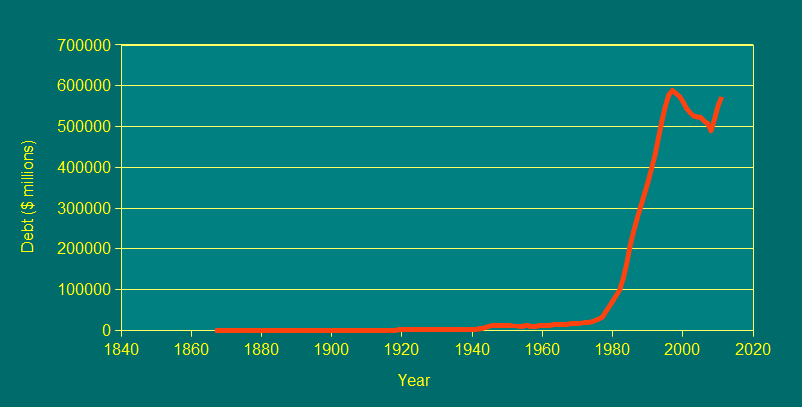

The above chart illustrates the history of Canada’s federal debt; obviously something went terribly wrong after 1974. Over a 108 year period (1867-1974) the accumulated debt shows as nearly a flat line growing to only $21.6 billion. But around 1974, the debt began to grow exponentially and, over a mere 39 years, it reached over $600 billion in 2013.
So, what happened around 1974? In that year
To achieve that goal, the Committee discouraged borrowing from a nation’s own central bank interest-free and encouraged borrowing from private creditors
“the Basel Committee was established by the central-bank Governors of the Group of Ten countries of the member central banks of the Bank for International Settlements (BIS), which included Canada. A key objective of the Committee was and is to maintain “monetary and financial stability.” To achieve that goal, the Committee discouraged borrowing from a nation’s own central bank interest-free and encouraged borrowing from private creditors, all in the name of “maintaining the stability of the currency.”
The presumption was that borrowing from a central bank with the power to create money on its books would inflate the money supply and prices. Borrowing from private creditors, on the other hand, was considered not to be inflationary, since it involved the recycling of pre-existing money. What the bankers did not reveal, although they had long known it themselves, was that private banks create the money they lend just as public banks do. The difference is simply that a publicly-owned bank returns the interest to the government and the community, while a privately-owned bank siphons the interest into its capital account, to be re-invested at further interest, progressively drawing money out of the productive economy.1
Paul Hellyer, also notes that lobbying by the banks and adoption of monetarism — the idea that “markets know best” and should be without regulation, and that public services should be privatized — took hold.
So, around 1974, the Government of Canada began to borrow all of the monies to cover its shortfalls from the private sector at interest rather than creating money through the Bank of Canada interest-free. In other words, since 1974, the Bank of Canada has not been acting in the best interest of its shareholders: the people of Canada.
To understand how ridiculous the present situation is, consider the 1993 Auditor General of Canada report (Section 5.41)3 which states:
“Of this, $37 billion represents the accumulated shortfall in meeting the cost of government programs since Confederation. The remainder, $386 billion, represents the amount the government has borrowed to service the debt created by previous annual shortfalls.
The cost of borrowing is the third area that affects the annual deficit. In 1991-92, the interest on the debt was $41 billion. This cost of borrowing and its compounding effect have a significant impact on Canada’s annual deficits. From Confederation up to 1991-92, the federal government accumulated a net debt of $423 billion. Of this, $37 billion represents the accumulated shortfall in meeting the cost of government programs since Confederation. The remainder, $386 billion, represents the amount the government has borrowed to service the debt created by previous annual shortfalls.”
In other words, of the accumulated debt of $423 billion, the government really needed to borrow only $37 billion—accumulated over 127 years—to cover its shortfalls on real spending for goods and services. The rest of that accumulated debt was monies borrowed to service the debt, essentially a payment of interest on interest to the private sector when the government could have created the money to cover the shortfall at what amounts to be no interest.
In 2011, alone, Canadian taxpayers paid the private banks an estimated $37.7 billion to service the federal debt
According to Paul Hellyer, from 1974–1975 to 2010, Canadian taxpayers have paid one trillion, 100 billion dollars ($1,100,000,000,000) in interest on the federal debt to private lenders.4 In 2011, alone, Canadian taxpayers paid the private banks an estimated $37.7 billion to service the federal debt—over $103 million each and every day of the year!5 These are tax dollars that, ceteris paribus, could have gone towards infrastructure, health care, education, and other social needs (see examples in Table 1, below) if the Government of Canada used the Bank of Canada to create the money to cover its shortfall. Ultimately, the government could pay off the federal debt through the same means.
Number Entity
Table 1. Examples of goods and services that $103 million could purchase. For example, $103 million–one day’s interest on the federal debt–could pay the salaries of 1,550 nurses or 340 doctors.
30 MRI Units
33 Small hospitals
25,750 People added to Canada Health Care roles
340 Doctors
1,550 Nurses
110 Community centres
7 High schools
6,645 Students funded to attend university (tuition; room & board)
And consider this: from confederation to 1974, Canada fought two world wars, went through a major depression, constructed major infrastructures such as the St. Lawrence Seaway, Trans-Canada Highway, International airports, Canadian National Railway, and brought in social welfare programs such as Family Allowance, Old Age Security pensions, Canada Pension Plan, Universal Health Care and wound up with a total accumulated debt of only $21.6 billion. Today our federal debt is approaching $600 billion and the government is continually cutting services while our infrastructure is not being maintained. Meanwhile, the private banks keep increasing their already obscene profits. This “subsidy” to the private banks must end.
The Solution
The solution to this problem is simply for the government to stop borrowing money from the private banks at interest and borrow from the Bank of Canada at no interest. The private banks should also be prevented from creating money. That right should be returned to the People of Canada through the Bank of Canada.
To understand more about this issue, see the sites and articles below, watch the videos and see also Money Creation and Economic Growth on this web site.
Articles and Web Sites
Public banking in America. A number of the associated videos also discuss the Canadian banking system.
full article can be viewed here with charts and graphs
Richard Paul
You must be logged in to post a comment.